
FOR today’s entry I was inspired by a series of photos cartoonist Danny Hellman recently shot on a stretch of Utica Avenue, one of Brooklyn’s lengthy north-south “NY Cities” series in mid-borough. The avenue runs from Fulton Street and Malcolm X Boulevard (formerly Reid Avenue) south to Flatbush Avenue and Avenue S, crossing Crown Heights, East Flatbush and into Marine Park. Two subway lines have Utica Avenue stops, the Fulton Street IND (A, C; express) and Eastern Parkway IRT (3, 4).
Going east to west in mid-Brooklyn, a series of avenues are named for cities beginning with New York and Brooklyn (an independent city when the avenue was named) going north along the Hudson River to Albany and then west along the Erie Canal to Lake Erie; other cities are Kingston, Albany, Troy, Schenectady, Utica, Rochester and Buffalo. Syracuse, which is a few miles south of the Erie Canal, was skipped, and Rochester is a bit north of it. Utica, a city of about 65,000, was known during the 19th and 20th Centuries for its involvement in the textile and coal industries.
Utica Avenue, which has two express bus lanes, has been posited for decades for a new subway line ever since the never-built IND Second System in the 1930s. All I can say is, good luck with that; it took over 40 years to build four stops on the Second Avenue.
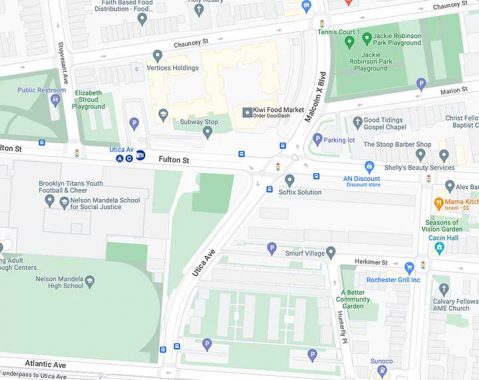
A few decades ago, the Department of Transportation (which in 2023 seems more interested in making things tough on motorists) executed a major traffic redesign at the north end of Utica Avenue, which formerly ended at Fulton Street between Stuyvesant Avenue and Malcolm X Boulevard. It acquired and knocked down some properties and redirected Utica Avenue and MXB so they would flow into each other under control of the same traffic signals at Fulton Street. A similar redesign was done a few blocks west so that northbound Troy Avenue traffic could go directly into Lewis Avenue.
On this map, note Hunterfly Place at bottom right. It is a remnant of a precolonial road the Dutch called Hunterfly Road. The name is an Anglicization of the Dutch “Aander Vly” which means “to the low, or swampy, place” and was on a Native American trail that went southeast to Jamaica Bay. Another section of Hunterfly Road at Bergen Street is home to the historic Weeksville Houses.
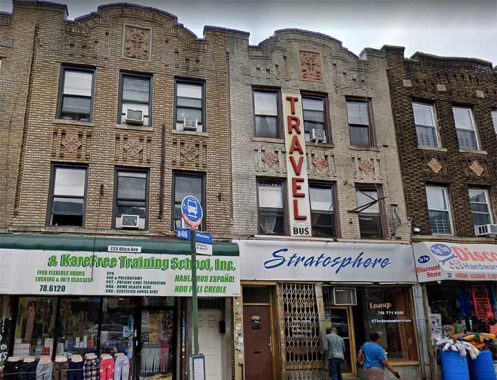
What attracted me to Danny’s photos is Utica Avenue’s collection of leftover store signage from previous tenants such as this travel agent sign at #227 Utica between Sterling and St. John’s Places. If you look carefully you can see the old Greyhound logo. I doubt this was ever a bus terminal, but I imagine tickets were sold here.
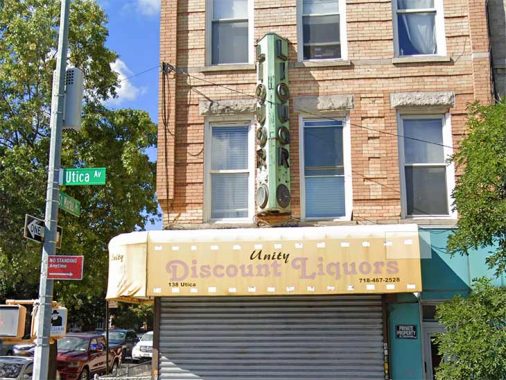
Neon liquor store sign with clock, #138 Utica Avenue at St. Mark’s Avenue.
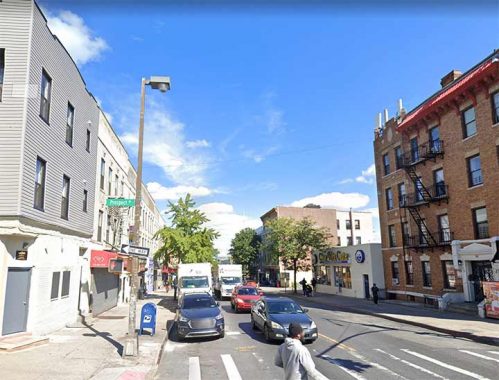
Utica Avenue has a NYC lamppost species that is getting rarer, the square-shafted “shoebox” lights; I do not know the manufacturer, but I named them “shoeboxes” because of the light fixture housing. This make can be found scattered around mid-Brooklyn on Utica and Church Avenues; they were formerly used on 5th Avenue in Park Slope. A lone specimen can be found at Bedford Avenue and North 7th in the heart of Williamsburg. Most still employ yellow sodium lights, and if they can’t be converted to LED, they’re likely endangered. this batch is on the stretch of Utica between Pacific Street and East New York Avenue., with this one at Prospect Place.
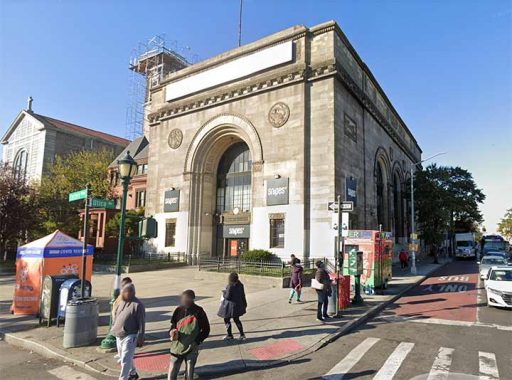
East New York Savings Bank, Parkway Branch building, 1117-1123 Eastern Parkway at Utica Avenue, was declared an individual NYC Landmark in 2015. It was designed by the firm of Holmes & Winslow and completed in 1928, the same year as One Hanson (Williamsburg Bank Building) for decades Brooklyn’s tallest. In 2023 it was home to Snipes, an athletic wear chain.

The general concept of the parkway system, devised by master urban architect Frederick Law Olmsted in the 1860s, was to extend large parks by making the roads that connected them into parks themselves. Olmsted’s vision can be seen in Brooklyn’s Ocean and Eastern Parkways, and in the Bronx’ Mosholu Parkway and Pelham Parkway (whose official name is the Bronx and Pelham Parkway because it connects Bronx and Pelham Bay Parks). Mosholu Parkway’s original stretch between the Bronx and Van Cortlandt Parks is still wonderfully intact.
Unfortunately, the “parkway” concept of Brooklyn’s Ocean and Eastern Parkways is largely lost as these roads now serve mainly as conduits for pedal-to-the-metal traffic from Prospect Park south to Coney Island (and its adjoining Belt Parkway) and from Prospect Park east to Bushwick Avenue (where a traffic transfer to the Jackie Robinson (Interborough) Parkway is close by.

In the 1990s, Eastern Parkway as far east as Ralph Avenue was refurbished and given its own set of distinctive stoplights and lampposts. Virtually unique in the city, their bases resemble beefed-up, steroidal versions of the Type B park post or Type G lamp formerly employed on side streets.
Eastern Parkway was constructed between 1870 and 1874 between Grand Army Plaza and Ralph Avenue as a true parkway, with greenways on both its “service roads.” This was still the horse and buggy era and Dobbins were the swiftest method of transportation. The parkway was extended northeast to Bushwick Avenue in the 1890s.
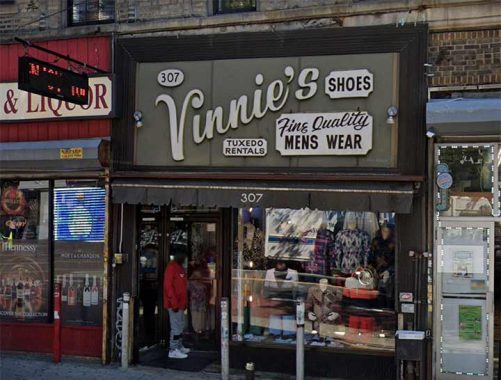
Old school vinyl sign, Vinny’s Shoes, 307 Utica Avenue south of Union Street.
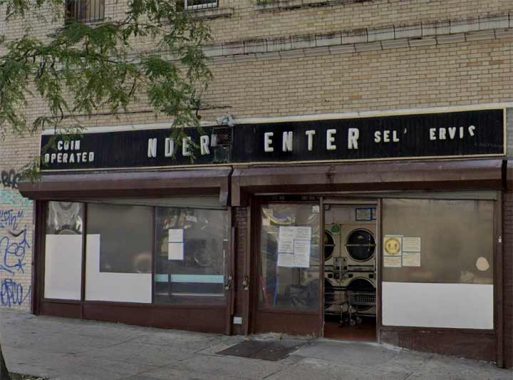
There are certain businesses that lend themselves to the presence of older signage. Laundromats is one such; they exist for years under the same management, so there’s no need to change the sign. Liquor stores are in the same category. However, some are in need to TLC, such as “Launder Center” at #397 Utica just south of Crown Street.
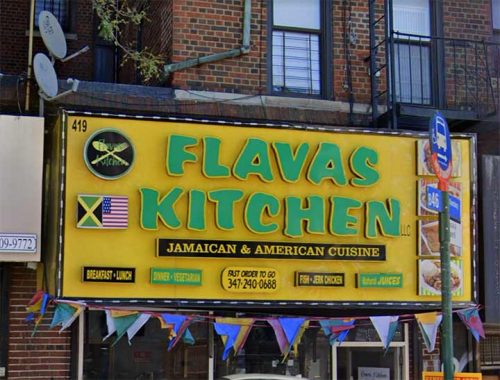
Flavas Kitchen, #419 Utica Avenue south of Montgomery Street, has a sign featuring the colors of the flag of Jamaica, black, green and gold. As this is written in late August, we are nearing the annual West Indian Day Parade which occurs on Labor Day on Eastern Parkway most years.
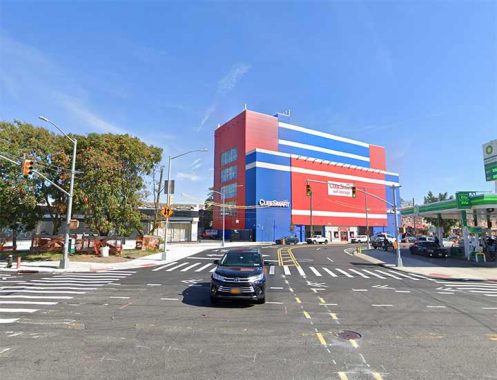
Looking east on East New York Avenue at Utica Avenue. Recently, another traffic redirection was made, connecting Remsen Avenue and ENY Avenue directly and eliminating Remsen Avenue’s intersection with Utica Avenue. A large storage facility, Cube Smart, can be seen at the intersetion.
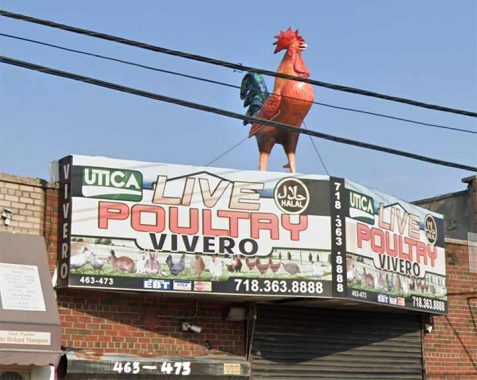
Utica Avenue changes character somewhat south of ENY Avenue, away from residential (though multidwelling buildings can still be found) and toward auto collision repair, tire shops and gas stations as well as poultry wholesalers. This distinctive sign can be found at Utica Avenue and Maple Street.

Mike’s Diner, Utica Avenue and Winthrop Street, fell on hard times in the 2010s and is now a venue where bills are most definitely posted, after it closed in 2019. It was built by DeRaffele and Sons.
The 7,515 square foot diner that stretches across the corner of Utica Avenue and Winthrop Street, was initially built in 1931, and according to “Diners of New York” by Michael Engle and Mario Monti, was one of the few classics left from the 1925 to 1945 golden age of diners in the city.
East Flatbush, and neighborhoods like Williamsburg, East New York, Canarsie, Bensonhurst, Bay Ridge, Sheepshead Bay, Flatlands, and Bath Beach, were all home to these retro diners, and in some cases, continue to serve primarily residential and now racially diverse areas. [Politics NY]

This ancient “Laundermat” sign (spellings are variable) can be found on Clarkson Avenue east of Utica. A laundry remains in the space.
As always, “comment…as you see fit.” I earn a small payment when you click on any ad on the site.
8/27/23

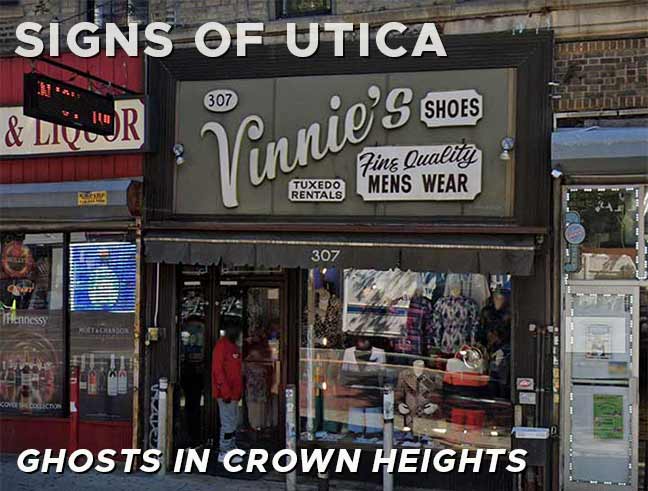
18 comments
Because Laundromat was once a trademark, you’ll find any number of spellings of the “close but not quite” variety as the owners tried to avoid trademark infringement. According to Consumers Reports:
Laundromat: Named by George Edward Pendray, Westinghouse Electric introduced the Laundromat in 1940, the first automatic washing machine that could be wall-mounted. It was last registered to Westinghouse in 1952, and has since expired as a trademark:
The building with the travel sign may have actually been a greyhound stop. When I lived in Queens Village, there was a convenience store on Hillside and Springfield, that had a similar sign and that is where I boarded the bus to go to Boston to see relatives.
For many years Vinnie was the official first name for boys in Brooklyn.
(But dont ever call them Vincent,or youll getta punch in the mout’)
Funny– I thought it was Vito, but what do I know?
Chris: Are you a WOR 710 listener? Talk radio host Mark Simone has a regular caller, “Vincent from Brooklyn”, who fits your characterization. He has an interesting perspective on current events & local/national politics if you know what I mean.
The “Laundermat” spelling in the last picture may be there for a reason. Until about 30 years ago “Laundromat” was a trademark of Westinghouse Electric.
Nice work Kev!
No,not a WOR listener since they started running Jean Shepherd re-runs sometime
in the early 70s.It got so bad I figured “Why bother?Its just going to
be another re-run.”
I think the fad for Vinnie names died out in the 50s.There were no Vinnies in my school
at St. Charles in the Heights in the 1960s
And I stopped with WABC the day the music died.”So bye bye Miss American Pie….”
Jean Shepherd: I remember him well. In the ’70’s he wrote a monthly column in Car & Driver for a while. To this day, “Christmas Story” has become a fixture on cable TV every year. we won’t see public personas of his
caliber again, unfortunately.
According to the Baby Name Grapher, successor to the defunct though better Baby Name Wizard, Vincent as a given name had two distinct peaks, in the 1910-1919 decade and again in the 1960’s. It was the 72nd most popular boys’ name in the first peak and 71st in the second.
Yet Vincent has not died out, ranking in 123rd place in 2022.
The original Erie Canal, built in the 19th century, passed right through the center of Syracuse (now Erie Blvd East and Erie Blvd West). The more modern Barge Canal system, built in the 20th Century, rerouted canal traffic around Syracuse to the north.
A real mystery why Syracuse was excluded.
The original Erie Canal also went through downtown Rochester. Rochester of course is known for the founding and failure of several large companies. Was Syracuse ever known for anything?
Basketball team
Syracuse was know for Carrier Air Conditioners (where the Carrier Dome for Syracuse University is).
Does anyone remember the Greyhound ticket counter in Downtown Brooklyn on Livingston Street?
Sure do. There was a Popeye’s next door and the IHOP originally was located on the ground floor of the old municipal garage, wrapping around Bond Street. The morons in DOT who thought changing the traffic flow on Bond to feed into Schermerhorn Street was a great idea should strung up. Remember the inland sea that appeared on the SW corner of Bond & Livingston after it rained? One would think with all of the construction since 2007 that the storm drain would’ve been cleared out.by now.
That “Laundermat” (now spelled “Laundromat” above the door) appears to still be open, at least when the last Google streetview photo was taken in 2022.